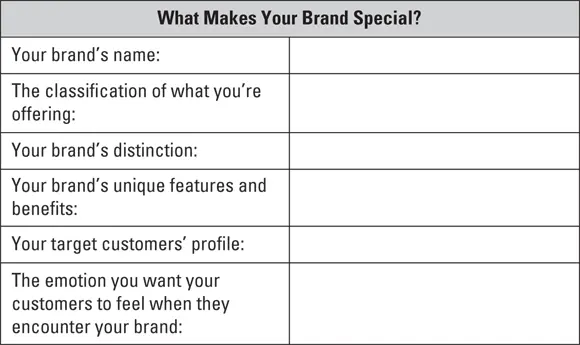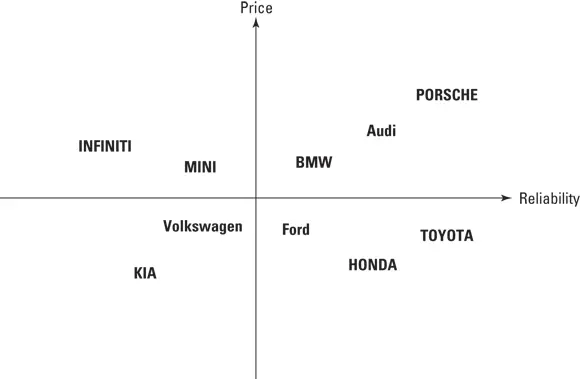Amy Will - Launching & Building a Brand For Dummies
Здесь есть возможность читать онлайн «Amy Will - Launching & Building a Brand For Dummies» — ознакомительный отрывок электронной книги совершенно бесплатно, а после прочтения отрывка купить полную версию. В некоторых случаях можно слушать аудио, скачать через торрент в формате fb2 и присутствует краткое содержание. Жанр: unrecognised, на английском языке. Описание произведения, (предисловие) а так же отзывы посетителей доступны на портале библиотеки ЛибКат.
- Название:Launching & Building a Brand For Dummies
- Автор:
- Жанр:
- Год:неизвестен
- ISBN:нет данных
- Рейтинг книги:5 / 5. Голосов: 1
-
Избранное:Добавить в избранное
- Отзывы:
-
Ваша оценка:
- 100
- 1
- 2
- 3
- 4
- 5
Launching & Building a Brand For Dummies: краткое содержание, описание и аннотация
Предлагаем к чтению аннотацию, описание, краткое содержание или предисловие (зависит от того, что написал сам автор книги «Launching & Building a Brand For Dummies»). Если вы не нашли необходимую информацию о книге — напишите в комментариях, мы постараемся отыскать её.
Launching & Building a Brand For Dummies,
Launching & Building a Brand For Dummies
Launching & Building a Brand For Dummies — читать онлайн ознакомительный отрывок
Ниже представлен текст книги, разбитый по страницам. Система сохранения места последней прочитанной страницы, позволяет с удобством читать онлайн бесплатно книгу «Launching & Building a Brand For Dummies», без необходимости каждый раз заново искать на чём Вы остановились. Поставьте закладку, и сможете в любой момент перейти на страницу, на которой закончили чтение.
Интервал:
Закладка:
 This brand positioning strategy enables you to charge more than your competitors and attract quality-conscious customers. An even more powerful strategy is to combine quality with low cost. If you can deliver higher-quality products for less money, customers won’t have much reason to buy from your competitors.
This brand positioning strategy enables you to charge more than your competitors and attract quality-conscious customers. An even more powerful strategy is to combine quality with low cost. If you can deliver higher-quality products for less money, customers won’t have much reason to buy from your competitors.
Cost and value
Many brands choose to compete simply by offering the lowest prices, and some are successful at it — Walmart, for example. This strategy generally undermines the purpose of branding, however. It’s the right approach if you’re selling a commodity (something that’s pretty much the same regardless of who’s making it or selling it), but it’s usually the wrong approach for a brand (something distinct that people are willing to pay more for).
Competing on value is usually a more effective strategy as long as you consider the cost to you. With the value strategy, you’re offering people more for their money. But adding value doesn’t necessarily cost you more. You may be able to introduce a superior product or service that doesn’t cost you more to produce but that you can charge more money for.
 Competing on cost alone is usually a loser’s game that drives down revenue across an industry, but it can work with the right strategy.
Competing on cost alone is usually a loser’s game that drives down revenue across an industry, but it can work with the right strategy.
Credibility and trust
For career, service, and some personal brands, credibility and trust are top priorities and are high on the list of brand positioning strategies. You build credibility by demonstrating your knowledge and expertise via website and social media content, speaking engagements, podcasts, and videos. You build trust by being reliable and trustworthy and by demonstrating a track record of serving customers successfully, earning high ratings, positive reviews, and glowing testimonials.
Checking out the competition
When positioning a brand, you’re doing so relative to competitors — anyone and anything that draws attention and money from your brand. Competitors can be direct or indirect:
A direct competitor offers pretty much the same thing you do.
An indirect competitor presents alternatives to what you offer.
For an airline, another airline is a direct competitor, whereas high-speed rail would be an indirect competitor — one that offers an alternative to flying.
When you’re creating a brand, you need to know what you’re up against, so check out the competition. Here are a few ways to identify your competitors and find out how they’re positioning their brands:
Search the web for what your brand offers to find brands that offer the same thing or something similar.
After finding potential competitors via a web search, explore their websites to see how they’re positioning themselves. Check out their mission and value statements, their visuals, their blog posts, and any testimonials they’ve posted.
Use Similarweb ( https://www.similarweb.com ) to identify sites similar to those of brands you’ve already identified as competitors (or sites that are similar to your own). Similarweb provides analytics for popular websites; if you’re researching smaller brands, you may find little to no info about them there.
Check out your competitors’ social media profiles, posts, and comments from their followers or fans.
Shop in your competitors’ stores; buy and use their products and services. Experiencing your competitors as a customer can provide fresh insight into what they do better than you, and vice versa.
Identifying what makes your brand different and better
Brand positioning is all about differentiation — demonstrating that what you offer is special. Think in terms of your industry, the specific market segment you’re targeting, the features and benefits of what your brand offers, and the emotion you want people to feel when they encounter your brand. Complete the form shown in Figure 3-1 to identify what makes your brand special (different and better). As you complete the form, refer to the following descriptions of each field in the form:
Your brand’s name: You name your brand later in this chapter. For now, just enter a tentative or placeholder name — something that describes your brand.
The classification of what you’re offering: Enter the industry, market, or product/service class, such as grocery delivery service, family dental practice, or online sports betting.
Your brand’s distinction: Enter a word or phrase that distinguishes your brand in its class, such as first, best, fastest, most highly rated, or coolest.
Your brand’s unique features and benefits: Briefly describe what makes your brand distinctive in terms of features and benefits. See the earlier section “ Product/service features and benefits” for details.
Your target customers’ profile: Briefly describe the people you want to be most enthusiastic about your brand, such as parents committed to their children’s health, strong women dedicated to the environment, seniors who want to stay fit, or people who are afraid of being attacked or robbed in their own homes.
The emotion you want your customers to feel when they encounter your brand: Specify how you want customers to feel about your brand, such as safe, secure, confident, successful, comfortable, or pampered.
The completed form reveals what makes your brand different and better in the eyes of those who matter most: your target customers.

FIGURE 3-1:Determine what makes your brand special.
Identifying your place on a brand positioning map
One of the most effective tools for brand positioning is a brand positioning map (or perceptual map ), which illustrates the relative position of two or more brands with respect to two attributes that are key to the success of those brands, such as price and quality, healthy and tasty, reliability and luxury, or customer experience and location.
Figure 3-2 shows a brand positioning map for various automobile manufacturers, showing their relative positions in terms of how consumers may perceive their price and reliability.

FIGURE 3-2:A brand positioning map.
To create a brand positioning map, take the following steps:
1 Choose two brand attributes that matter most to your brand in the competitive environment in which it exists (or will exist).
2 Draw a two-axis grid with an axis for each attribute, and label the extremes on each axis.You might label one end of the axis Expensive and the other end Inexpensive, for example.
3 Plot points for your brand and competing brands on the grid to show their positions with relation to the two attributes.
Repeat this exercise for several key attributes.
 Consider plotting two points for your brand to show where it’s positioned now and where you’d like it to be positioned 6 or 12 months down the road. The space between the points will provide a general measure of how much progress you need to make and in which directions.
Consider plotting two points for your brand to show where it’s positioned now and where you’d like it to be positioned 6 or 12 months down the road. The space between the points will provide a general measure of how much progress you need to make and in which directions.
Интервал:
Закладка:
Похожие книги на «Launching & Building a Brand For Dummies»
Представляем Вашему вниманию похожие книги на «Launching & Building a Brand For Dummies» списком для выбора. Мы отобрали схожую по названию и смыслу литературу в надежде предоставить читателям больше вариантов отыскать новые, интересные, ещё непрочитанные произведения.
Обсуждение, отзывы о книге «Launching & Building a Brand For Dummies» и просто собственные мнения читателей. Оставьте ваши комментарии, напишите, что Вы думаете о произведении, его смысле или главных героях. Укажите что конкретно понравилось, а что нет, и почему Вы так считаете.












